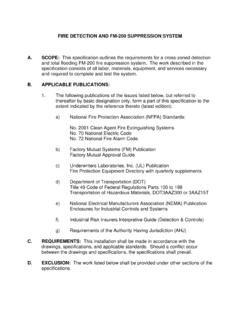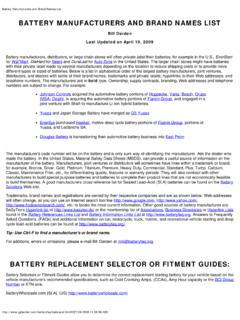Transcription of FIRE DETECTION AND FM-200 SUPPRESSION ... - Interstate Fire
1 FIRE DETECTION AND FM-200 SUPPRESSION SYSTEM A. SCOPE: This specification outlines the requirements for a cross-zoned DETECTION and total flooding FM-200 fire SUPPRESSION system. The work described in the specification consists of all labor, materials, equipment, and services necessary and required to complete and test the system. B. APPLICABLE PUBLICATIONS: 1. The following publications of the issues listed below, but referred to thereafter by basic designation only, form a part of this specification to the extent indicated by the reference thereto (latest edition): a) National Fire Protection Association (NFPA) Standards: No. 2001 Clean Agent Fire Extinguishing Systems No. 70 National Electric Code No. 72 National Fire Alarm Code b) Factory Mutual Systems (FM) Publication Factory Mutual Approval Guide c) Underwriters Laboratories, Inc.
2 (UL) Publication Fire Protection Equipment Directory with quarterly supplements d) Department of Transportation (DOT) Title 49 Code of Federal Regulations Parts 100 to 199 Transportation of Hazardous Materials, DOT3 AAZ300 or 3 AAZ15T e) National Electrical Manufacturers Association (NEMA) Publication Enclosures for Industrial Controls and Systems f) Industrial Risk Insurers Interpretive Guide ( DETECTION & Controls) g) Requirements of the Authority Having Jurisdiction (AHJ) C. REQUIREMENTS: This installation shall be made in accordance with the drawings, specifications, and applicable standards. Should a conflict occur between the drawings and specifications, the specifications shall prevail. D. EXCLUSION: The work listed below shall be provided under other sections of the specifications.
3 1. 120 VAC power to the FM-200 panel, graphic annunciators and maintenance panel. 2. Interlock conduit and wiring to ventilation equipment, dampers, and shunt-trip breakers 3. Tie-in of FM-200 panel to house fire alarm and/or security system. E. GENERAL: 1. The system and components shall be a Kidde Fire SUPPRESSION System as manufactured by KIDDE FIRE SYSTEMS, INC., 400 Main Street, Ashland, MA. 2. The equipment shall be supplied and installed by Interstate FIRE PROTECTION, North Conway, NH or Gardiner, ME 3. Qualifications of installer/contractor: a) The system shall be installed by an experienced firm regularly engaged in the installation of automatic FM-200 fire extinguishing systems in strict accordance with NFPA standards. b) The contractor's firm must have a minimum ten (10) years experience in design, installation, and testing FM-200 or similar fire SUPPRESSION systems.
4 A list of systems of similar nature and scope shall be provided at the time of proposal. c) The installation Contractor shall be an authorized stocking distributor of the manufacturer for the equipment included in the system so that immediate replacement parts can be made from inventory. He shall show proof of available telephone communications on a twenty-four hour, seven-days-a-week basis; his service personnel shall be available for emergency service at all times. 4. Insurance Requirements: a) The FM-200 systems contractor shall show evidence that he carries a minimum $2,000, liability and completed operations insurance policy. b) These limits shall supersede limits required in the general conditions of the specifications. F. SUBMITTALS 1. The following shall be submitted for approval prior to the start of installation: a) Shop drawings and component details: 1) Manufacturer's certificate of acceptance of the qualifications of the installing contractor to install, test, maintain, and recharge the manufacturer's equipment.
5 2) Shop drawing shall indicate locations, installation details, and operation details of all equipment associated with the FM-200 system. Floor plans showing equipment locations, piping, conduit runs, and other details, as required, be provided. Elevations, cross section, and other details shall be drawn. 3) Sequences of operation, electrical schematics, and connection diagrams shall be provided to completely describe the operation of the FM-200 system controls. 4) The contractor shall illustrate the agent distribution system, and provide calculations to demonstrate the volumetric concentrations. G. SYSTEM DESCRIPTION AND OPERATION 1. The system shall be total flooding FM-200 extinguishing system designed to provide a uniform concentration of 7%, at normal average ambient temperature, minimum of FM-200 .
6 A) The amount of FM-200 to be provided shall be the amount required to obtain and hold the minimum uniform concentration for ten (10) minutes. The contractor shall take into consideration such factors as unclosable openings (if any), run-down time of fans, time required for dampers to close (and requirements for any additional dampers), and any other feature of the facility that could affect concentration. 2. The system shall be actuated by a combination of ionization and photoelectric smoke detectors. Automatic operation in each separate protected area shall be as follows: a) Actuation of one (1) detector in either loop shall: 1) Illuminate the respective zone (circuit) lamp on the control unit. 2) Energize a pre-alarm audible or audible/visual signal associated with that area in which the detector was operated.
7 3) Actuate door closer/holders on access doors to the protected area. 4) Transmit a signal to the building's fire alarm system. b) Actuation of a second detector in the same area, but on the second DETECTION loop, shall: 1) Illuminate the respective zone (circuit) lamp on the control unit. 2) Energize an evacuation audible and visual signal associated with the area in which the detector was operated. 3) Start time-delay sequence. 4) Shut down ventilation system and/or close dampers. c) Discharge of the FM-200 shall occur at the end of time-delay period. 3. The system shall be capable of being actuated by manual discharge stations located at each fire exit. Operation of manual discharge station shall duplicate the cross-zones sequence description above, except that time-delay shall be bypassed. The manual discharge station shall be of the electrical actuation type and be supervised at the control panel.
8 Local, manual, mechanical release shall be installed on each pilot cylinder. Systems that do not allow for this type of releasing shall not be permitted. H. MATERIALS AND EQUIPMENT 1. General Requirements: Materials and equipment shall be standard products of the manufacturer's latest design and suitable to perform the functions intended. When one or more pieces of equipment must perform the same functions, they shall be duplicates produced by one manufacturer. The name of the manufacturer and the serial numbers shall appear on all major components. 2. All devices and equipment shall be UL listed and/or FM approved. 3. All devices, equipment and components shall be products of the same manufacturer. 4. The FM-200 control panel shall be a Kidde, Aegis Control Panel, and shall perform the functions necessary to operate the DETECTION , control and release of the FM-200 SUPPRESSION System.
9 The panel shall accept input from the following types of equipment used to make up the system: smoke detectors, thermal detectors, and manual pull stations. The control unit shall be approved by Underwriters' Laboratories, Inc., and/or Factory Mutual as an FM-200 system control unit. This control unit shall be located as shown on plans. a) The control unit shall be housed in a wall mounted, sheet metal enclosure suitable for protecting electrical circuits. It shall be a NEMA Type 1 metal cabinet with hinged, locked doors. b) The control unit shall operate on 120 volts AC, 50/60 Hz. c) In the event of a loss of rectified power, visual and audible trouble signs shall be activated. d) The control unit shall contain a self-contained, 24 volts DC emergency power supply. The units shall have built-in, rechargeable standby batteries to provide a minimum 24-hour emergency power.
10 A trouble signal will be initiated if battery leads are disconnected or the battery is in an abnormally low state of charge. 5. Manual discharge stations shall be of the dual-action type, which will require that an outer door be lifted to expose the actuation door. The concealed release switch shall be double action SPST. The front shall be suitably labeled. Push button type manual discharge stations shall not be permitted. a) Manual actuation shall bypass the delay and abort functions and shall cause all alarm and shutdown devices to operate the same as if the system had operated automatically. 6. The detectors shall be spaced, located, etc., in accordance with the manufacturer's specifications and within the guidelines of NFPA standard 72E. 7. Each detector shall have a LED to indicate the status of the detector.


